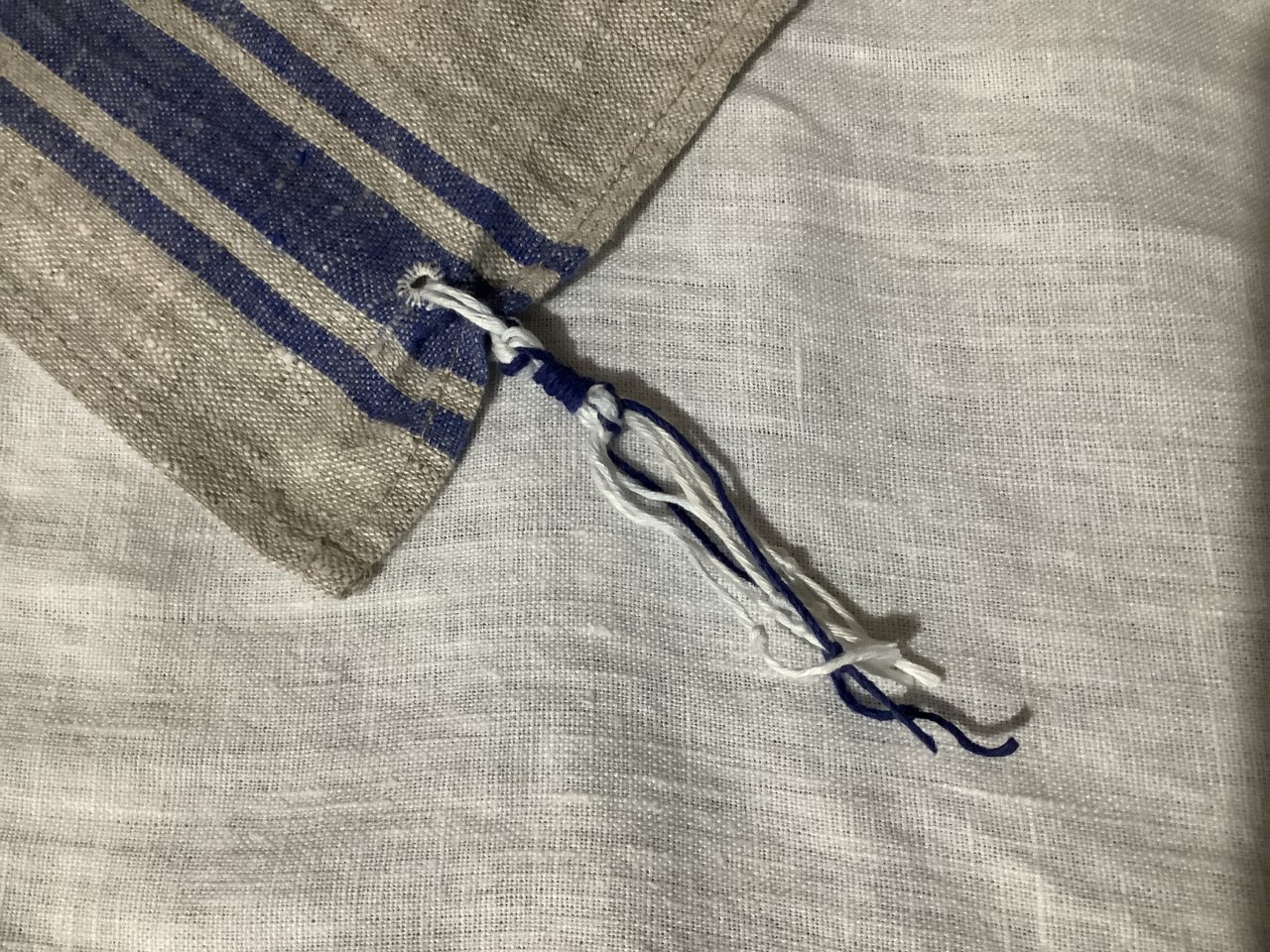
Garments give us a sense of continuity with our heritage and history. In many ways, our traditional garments are a declaration of who we are as a people. Because there are many common questions regarding garments, we will answer some of the more common questions here, so you will have the answers you need for the questions you will probably be asked.
To understand the ancient Hebrew garments, the first thing is to realize the importance the hand loom played. Because most clothing was woven on the hand loom, the patterns and styles remained fairly constant, except when Israel was invaded by foreigners, or taken into captivity.
On the hand loom, the lengthwise (warp) threads were stretched tight with weights, and then the horizontal (weft) threads were woven by hand. The easiest form of decoration was to make vertical stripes, by hanging colored threads lengthwise (on the warp). Then one could weft the same color back and forth horizontally, left to right and right to left. (Horizontal stripes and patterns were also used, but since solids colors and lengthwise stripes require less effort and concentration, they were more common in ancient times.)
As mentioned earlier, the cut of clothing was also typically much plainer since all sewing was done by hand. Once one had loomed a piece of cloth (or had paid to have it loomed), one wanted to wear all of the cloth one had paid for. Also, since sewing was done by hand, the fabric was often simply sewn together down the sides, resulting in a very full cut. This fuller cut is also considered very modest, as it hides the body well.
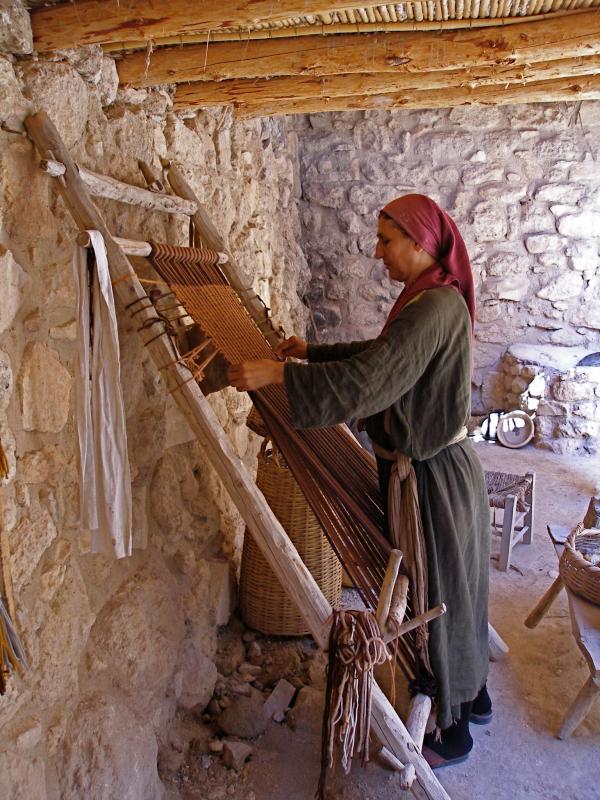
While Israelites tend toward tradition, foreign invaders or foreign captors did influence the clothing styles. Yet through it all, a woman’s clothing was typically long, going either to the mid-calf or to the ankles, covering the thigh (if not the whole leg). However, depending on the era, a woman might have her arms or even a shoulder exposed, perhaps because this made it easier to work.
Before the Roman era, men also typically wore their garments to the ankles. This provided more protection, but it also limited mobility. If a man needed to move more freely (for work, or for battle), he would gird up his loins. He would raise up the skirt portion of his ketonet (tunic), gather the excess fabric forward, and then pass it down through his legs. Then he would reach behind and bring half the fabric around each side, tying it in front. The effect was like a large diaper, but then he was able to run, or move much more freely.
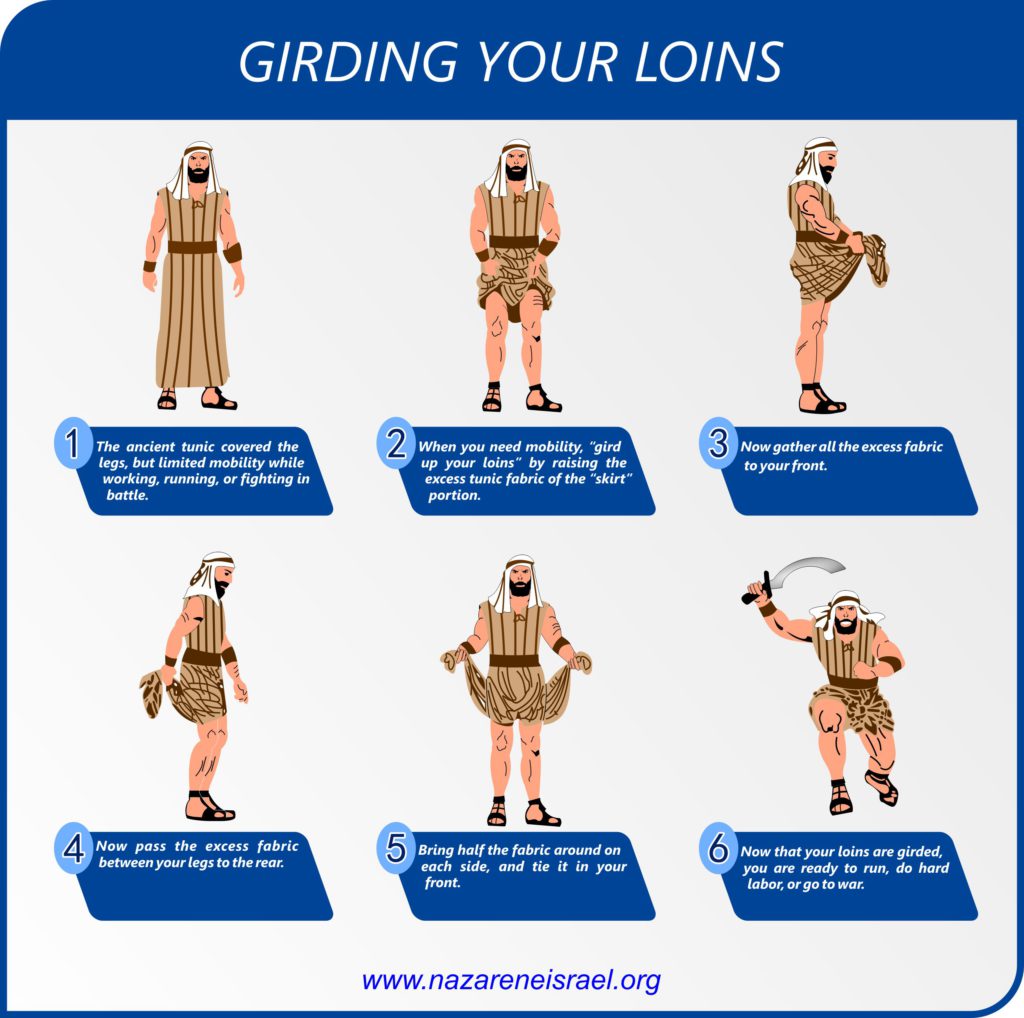
Melachim Aleph (1 Kings) 18:46
46 Then the hand of Yahweh came upon Eliyahu; and he girded up his loins and ran ahead of Ahab to the entrance of Jezreel.
Israelites were conservative, but practical. They would gird up their loins if there was heavy labor, or if they had to go to war, or run. However, when there was no longer a need for mobility, they ungirded their loins, to keep the thighs covered. (This changed in the Roman era, as the Romans felt a full skirt for men was effeminate.)
About Scriptural “Nakedness”
In some cultures it is felt that a gentleman should always wear his coat in public. Even if the weather is hot, if he goes out with only a shirt, he is considered “not dressed.” Likewise, in later times, it was thought to be improper for an Israelite man to go out in public without his simlah (his four cornered outer garment). If he went out in public without his simlah (that is, wearing only his tunic), he was thought to be naked. This was the case in Isaiah 20.
Yeshayahu (Isaiah) 20:2
2 At the same time Yahweh spoke by Isaiah the son of Amoz, saying, “Go, and remove the sackcloth from your body, and take your sandals off your feet.” And he did so, walking naked and barefoot.
Outer garments did not need to be worn while working. Kepha (Peter) had stripped down to his tunic (chiton, ketonet) for work, and thus was considered naked, even though he was still wearing his tunic.
Yochanan (John) 21:7
7 Therefore that disciple whom Yeshua loved said to Kepha, “It is Yahweh!” Now when Shimon Kepha heard that it was Yahweh, he put on his outer garment (for he was naked), and plunged into the sea.
We do not know why an Israelite was considered naked without a simlah. It may have to do with the fact that the simlah bears the tzitzit, and it was felt that a man was naked if not wearing his tzitzit in public. Alternately, it could also be how a woman might feel (half) naked if she went out in public in only a dress slip, or a negligee. Even though she is covered, something feels wrong to wear an only an undergarment as an outer garment.
Many Israelites were also very poor, and their simlah was a very valuable thing to them. Because the simlah was not worn for work, the simlah was often taken in pledge. In Exodus 22:26 the simlah is called a salmah (by letter transposition), but it is the same garment.
Shemote (Exodus) 22:26
26 “If you ever take your neighbor’s garment as a pledge, you shall return it to him before the sun goes down.”
When the pledge was not returned, in a very real sense it made the poor man “naked”, because he was deprived of his protection from the elements, and from the cold at night.
Iyov (Job) 22:6
6 “For you have taken pledges from your brother for no reason,
And stripped the naked of their clothing.”
Spiritual Symbolism of Garments in Scripture
Our clothing also has spiritual connotations in Scripture. It can symbolize our righteous works, our inner nature, or our inner spiritual state. For example, in Revelation, 19:8, our garments symbolize our righteous acts.
Hitgalut (Revelation) 19:8
8 And to her it was granted to be arrayed in fine linen, clean and bright, for the fine linen is the righteous acts of the saints.
If our righteous actions are thought to clothe us, let us consider this also with regard to the wedding garments Yeshua speaks of in the Parable of the Wedding Feast. Those who are called to the wedding, but who do not wear a wedding garment (righteous actions) will be cast into the outer darkness.
Mattityahu (Matthew) 22:11-14
11 “But when the king came in to see the guests, he saw a man there who did not have on a wedding garment.
12 So he said to him, ‘Friend, how did you come in here without a wedding garment?’ And he was speechless.
13 Then the king said to the servants, ‘Bind him hand and foot, take him away, and cast him into outer darkness; there will be weeping and gnashing of teeth.’
14 “For many are called, but few are chosen.”
Isaiah 61:3 tells us that those who truly follow and serve Yeshua with righteous actions will be given a “garment of praise” to replace their spirit of heaviness (mourning).
Yeshayahu (Isaiah) 61:3
3 “To console those who mourn in Zion,
To give them beauty for ashes,
The oil of joy for mourning,
The garment of praise for the spirit of heaviness;
That they may be called trees of righteousness,
The planting of Yahweh, that He may be glorified.”
There also may be spiritual symbolism in Luke 8:27, where the demon-possessed man appears stark naked.
Luqa (Luke) 8:27
27 And when He stepped out on the land, there met Him a certain man from the city who had demons for a long time. And he wore no clothes, nor did he live in a house but in the tombs.
Yet soon after his exorcism, the man is now “clothed and in his right mind.” So, did anyone bring him clothes? Or does this refer to his spiritual and mental state?
Luqa (Luke) 8:35
35 Then they went out to see what had happened, and came to Yeshua, and found the man from whom the demons had departed, sitting at the feet of Yeshua, clothed and in his right mind. And they were afraid.
Garments are also related to our spiritual state in the Parable of the Prodigal Son. When the younger son (Ephraim) repents, he comes back home to his father’s house, where he is given the best robe, which may also symbolize spiritual authority.
Luqa (Luke) 15:22
22 “But the father said to his servants, ‘Bring out the best robe and put it on him, and put a ring on his hand and sandals on his feet.”
The Procession of the Aamu (Aramu/Arameans)
Israel’s clothing styles have changed over time. They have been affected both when they were invaded, and when they went into foreign lands. An ancient Egyptian hieroglyph called the Procession of the Aamu depicts what some scholars believe is Israel when they went into Egypt. It is thought that the term Aamu may refer to the Aramu (Arameans), remembering that Avraham was called an Aramean (Syrian) in Deuteronomy 26:5.
Devarim (Deuteronomy) 26:5
5 “And you shall answer and say before Yahweh your Elohim: ‘My father was an Aramean, about to perish, and he went down to Egypt and dwelt there, few in number; and there he became a nation, great, mighty, and populous.’”

We can interpret this better if we remember that this was prior to the giving of the Torah. At this point in time, Israel was still under the order of Melchizedek (and the order of Melchizedek was still external to Israel). The male tunic does not have sleeves, and one shoulder is bare. Some of the men wear only loin cloths. The garments stop below the knee, and they wear sandals. The men do not wear any symbols of authority on their heads, perhaps because prior to the giving of the Torah, the men did not yet belong to any priesthood.
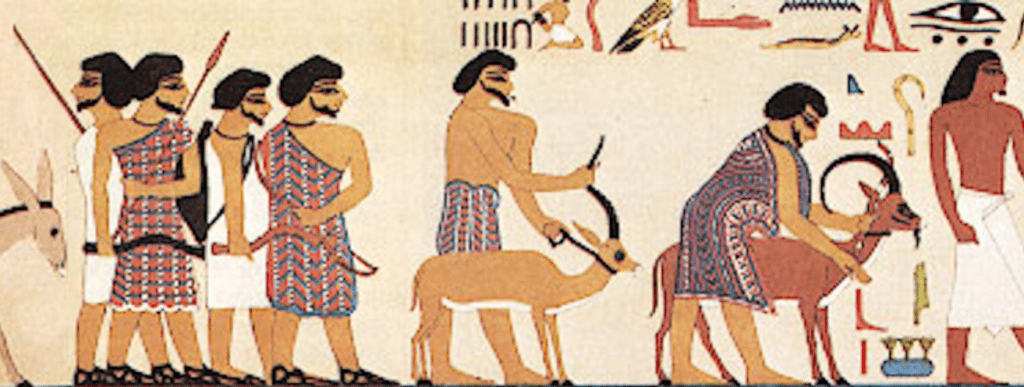
The leader of the procession is identified as Avisha the Hyksos. Avisha is a Hebrew name meaning gift of the Father. The name Hyksos may mean, “ruler of foreign lands.” Josephus, in his work Against Apion, says the name Hyksos refers either to shepherd kings or captive kings, and He identifies the Hyksos with Israel in the Exodus from Egypt. (This image is of the original, and is not retouched.)

For the women, the garment is also sleeveless, and one shoulder is bare. The skirt seems to stop mid-calf (which is longer than the men’s garments). The women also wear soft boots (with closed toes). They may even have some kind of sock, but in any event their shoes conceal the feet. And even though this speaks of a time before the Torah was given, the women wear a head band, which is perhaps a symbol of being under authority.

The Book of Gates
The Egyptian Book of Gates is another hieroglyph which depicts what the ancient Egyptians considered the four different races of the earth: the Egyptians, the Aamu (Aramaeans/Israelites), the Nubians (in roughly lower Egypt and upper Sudan), and the Syrians.
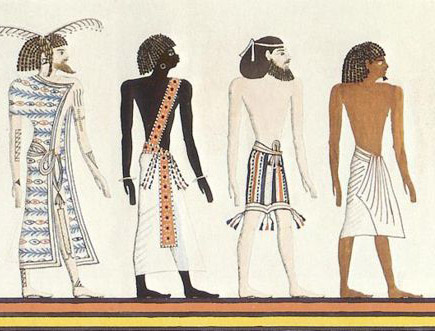
Slaves in Egypt typically wore only loincloths, yet even though they did not have four cornered garments, they still attached tzitzit to their loincloths. Further, their tassels were blue and red (contrary to the Talmudic myth that tassels must always be blue and white).

(For what it is worth, this seems consistent with the modern Ephraimite practice of putting tzitzit on belt loops, or putting tzitzit on one’s clothing by other means. However, to truly fulfill the commandment to put tassels on the four corners of our garments [re: Numbers 15:38], it helps to have a garment with four corners.)
Restoring the Four Cornered Garment and Tzitzit
As mentioned in the last chapter, the tallit did not exist in Yeshua’s time. Rather, Yeshua probably wore a white wool (or perhaps linen) simlah with short tassels, and he spoke against lengthening the tassels for looks.
Mattityahu (Matthew) 23:5
5 “But all their works they do to be seen by men. They make their phylacteries broad and enlarge the borders of their garments.”
Further, as mentioned in the first chapter, a longstanding Jewish complaint is that they do not want us to dress like them. The Orthodox wear specific items of clothing to distinguish one sect from another. They want to be able to tell at a glance what someone believes, so they can know whether or not they believe the same way, or if they want to let their children play with our children, etc. They think of it in terms of “truth in labeling” laws, and it makes them stumble when we adopt rabbinic items of clothing (such as the tallit with lengthened tassels).
Further, we mentioned earlier that a 2017 CE study by the reputable Barna Group found that 21% of Jewish millennials believed that Yeshua is the son of Elohim, while an additional 28% felt that although He was not the son of Elohim, He was nonetheless an important rabbi or spiritual teacher. That means 49% of millennial Jews are open to hearing about the teachings of Yeshua. Jews find garments extremely important, and it would help them to identify with Nazarene Israel if we had a specific set of garments they could identify with. So why not restore the original four cornered simlah, and other four cornered garments, seeing as Yeshua undoubtedly wore them?
Imitating Yeshua (not the Rabbis)
Although I have not been able to verify it, a Jewish rebbetzin once told me that the stripes on the tallit used to run lengthwise until the pattern was changed to run horizontally in the Middle Ages (as the rabbis thought it looked better). Other sources tell us that the simlah was typically a plain thin white wool. So if it would help for us to adopt a distinctive garment that Yeshua would have worn, why not adopt either a plain white simlah, or use the ancient pattern of lengthwise stripes? And rather than add a long rabbinic tassel with a cabalistic winding pattern, why not use the same short tassels that Yeshua would have used? This would testify without saying a word that we believe Yeshua is our example.
Because the Orthodox hate us and like to dictate terms, they will always find ways to complain, no matter what we do. However, if we imitate Yeshua there will not be anything they can truly say, because our goal will not be to imitate them (or use rabbinic items of clothing), but only to imitate our Leader. And, since imitating the sect leader was the custom in Yeshua’s time (as today), they will not be able to accuse us of anything except imitating our sect leader. This will have the additional advantage that those Jews who are interested in Yeshua will have an ancient Hebraic look that they can identify with, which also helps them to identify with their heritage.
Since there is no uniform requirement, you can add a tassel to the corners in the rabbinic fashion, but it should be short. Rather than the rabbinic winding patterns of 10-5-6-5 or 7-8-11-13, a simple 7 windings with short tails would create a nice short tzitzit that would be easy to identify as belonging to followers of Yeshua.
This is a picture of a linen tallit in a natural color (for weekdays) that had the 10-5-6-5 tzitzit windings cut and re-wound to a short set of 7 windings. The length is just under a hand span, so it is unlikely that the tassels will catch on anything. (The blue is spirulina, although indigo or any other blue will also work, as long as it does not come from a sea snail.)

Here is a hand-woven tallit katan (small tallit) in the poncho style that had blue warp threads added to the loom. The loom artist tied the loose ends as it came off the loom, making tassels. This is probably how the tassels looked in ancient Israel in the days when Yahweh gave the command to put a thread of blue in the tassels on the corner.
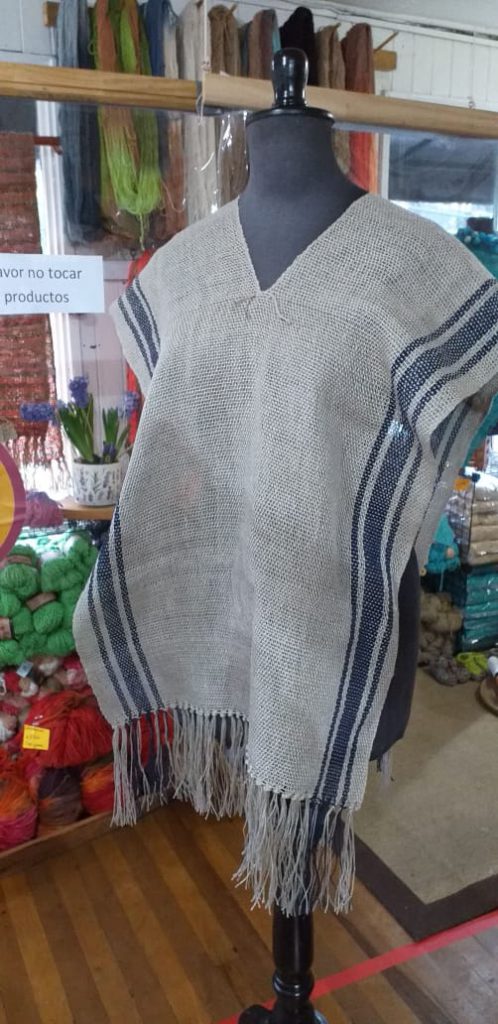
The tassels on the sides were loosened, and a thread of blue was added manually, literally to “put a thread of blue in the tassels on the corners” of the garment.

These tassels are in the tzitzit (lock of hair) style. They were trimmed to make them shorter. Alternately, you can also twist the tassels to form a g’dil style. This garment is in white, with blue on the border. (The weave is loose and stiff as the linen is still unwashed.)
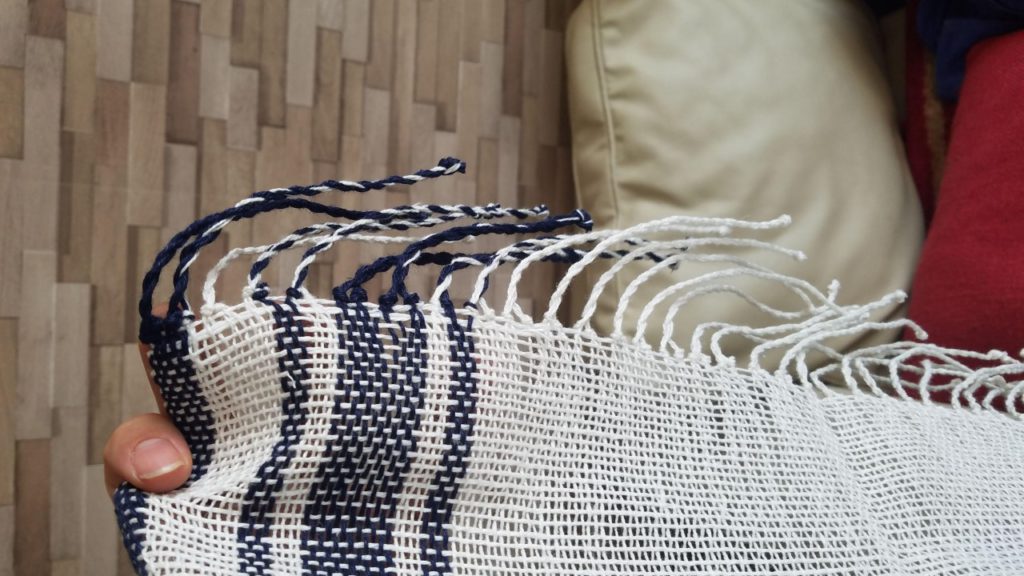
The advantage of putting blue warp threads right on the border is that when the tassels are made, they already have blue. (No blue needs to be added.)
Here is a weaving pattern we are adopting in Nazarene Israel. This pattern should identify you as a Nazarene Israelite (or Nazarene friendly).
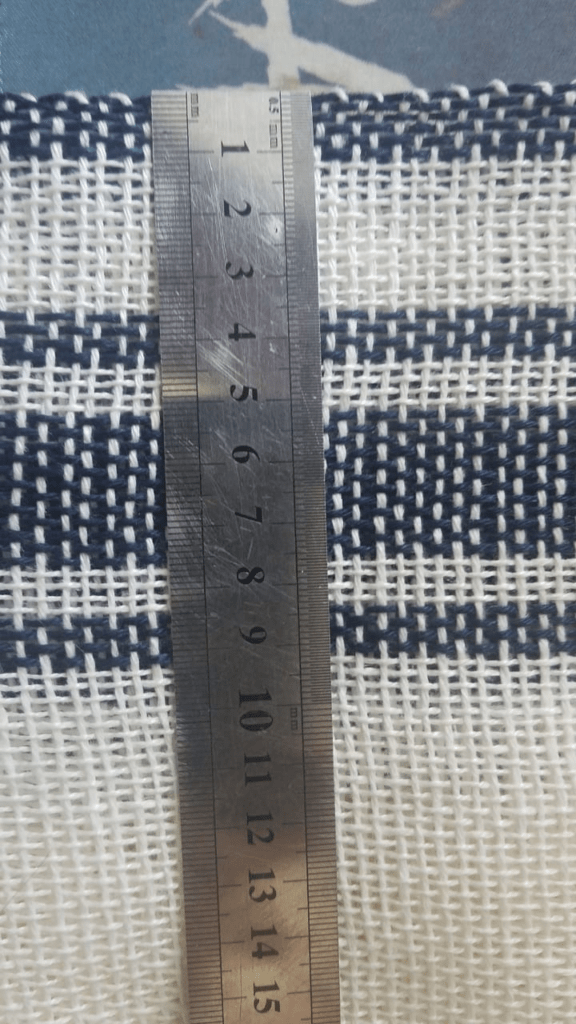
The outside edge is 6 blue warp threads (1.25 cm)
The next white is 12 white warp threads (2.5 cm)
The next blue is 4 blue warp threads (0.75 cm)
The next white is 4 white warp threads (0.75 cm)
The next blue is 12 blue warp threads (2.5cm)
The next white is 4 white warp threads (0.75 cm)
The inside blue is 4 blue warp threads (0.75 cm)
Here is how it looks being made on a small modern loom.
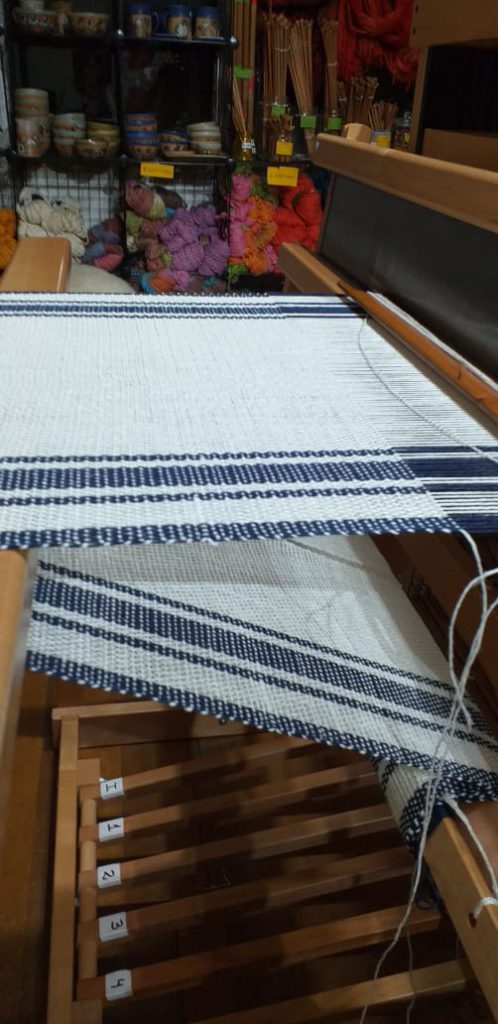
Although there is no uniform, we believe it would be very beneficial if this pattern (or longitudinal patterns similar to it) and first-century style short tzitzit were widely adopted within our people. We believe it would witness our faith in Yeshua without saying a word.